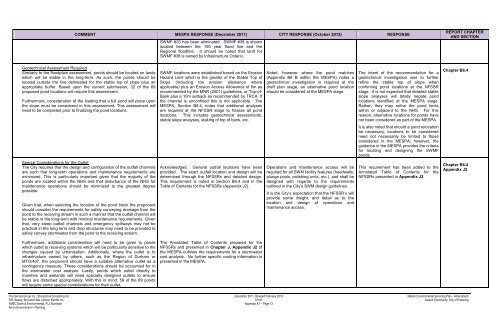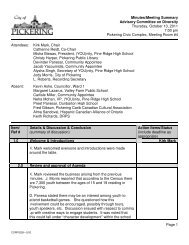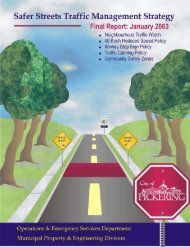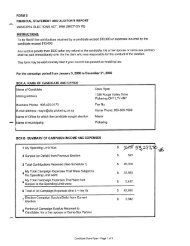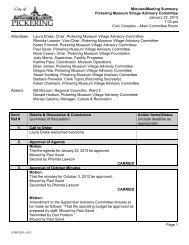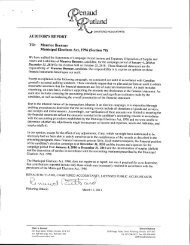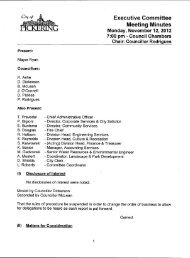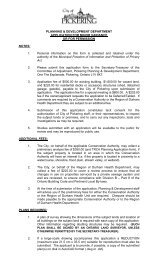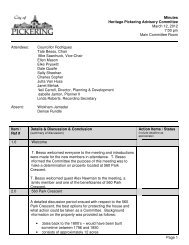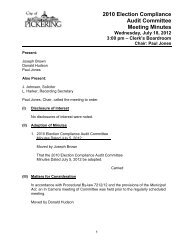Chapter A - Introduction - City of Pickering
Chapter A - Introduction - City of Pickering
Chapter A - Introduction - City of Pickering
Create successful ePaper yourself
Turn your PDF publications into a flip-book with our unique Google optimized e-Paper software.
COMMENT MESPA RESPONSE (December 2011) CITY RESPONSE (October 2012) RESPONSE<br />
SWMF #33 has been eliminated. SWMF #38 is shown<br />
located between the 100 year flood line and the<br />
Regional floodline. It should be noted that land for<br />
SWMF #38 is owned by Infrastructure Ontario.<br />
REPORT CHAPTER<br />
AND SECTION<br />
Geotechnical Assessment Required<br />
Similarly to the floodplain assessment, ponds should be located on lands<br />
which will be stable in the long-term. As such, the ponds should be<br />
located outside the line delineated for the stable top <strong>of</strong> slope plus an<br />
appropriate buffer. Based upon the current submission, 32 <strong>of</strong> the 69<br />
proposed pond locations will require this assessment.<br />
Furthermore, consideration <strong>of</strong> the loading that a full pond will place upon<br />
the slope must be considered in this assessment. This assessment will<br />
need to be completed prior to finalizing the pond locations.<br />
SWMF locations were established based on the Erosion<br />
Hazard Limit which is the greater <strong>of</strong> the Stable Top <strong>of</strong><br />
Slope (including toe erosion allowance where<br />
applicable) plus an Erosion Access Allowance <strong>of</strong> 6m as<br />
recommended by the MNR (2001) guidelines, or Top-<strong>of</strong>-<br />
Bank plus a 10m setback as recommended by TRCA. If<br />
the channel is unconfined this is not applicable. The<br />
MESPA, Section B6.4, notes that additional analyses<br />
are required at the NFSSR stage to finalize all pond<br />
locations. This includes geotechnical assessments,<br />
stable slope analyses, staking <strong>of</strong> top <strong>of</strong> bank, etc.<br />
Noted, however where the pond matrices<br />
(Appendix B6 B within the MESPA) notes a<br />
geotechnical investigation is required at the<br />
draft plan stage, an alternative pond location<br />
should be considered at the MESPA stage.<br />
The intent <strong>of</strong> the recommendation for a<br />
geotechnical investigation was to further<br />
refine the stable top <strong>of</strong> slope when<br />
confirming pond locations at the NFSSR<br />
stage. It is not expected that detailed stable<br />
slope analyses will totally negate pond<br />
locations identified at the MESPA stage.<br />
Rather, they may refine the pond limits<br />
within or adjacent to the NHS. For this<br />
reason, alternative locations for ponds have<br />
not been considered as part <strong>of</strong> the MESPA.<br />
<strong>Chapter</strong> B6.4<br />
It is also noted that should a pond relocation<br />
be necessary, locations to be considered<br />
need not necessarily be limited to those<br />
considered in the MESPA; however, the<br />
guidance in the MESPA provides the criteria<br />
for locating and designing the SWMF<br />
ponds.<br />
Special Considerations for the Outlet<br />
The <strong>City</strong> requires that the design and configuration <strong>of</strong> the outfall channels<br />
are such that long-term operations and maintenance requirements are<br />
minimized. This is particularly important given that the majority <strong>of</strong> the<br />
ponds are located within the NHS and that disturbance <strong>of</strong> the NHS for<br />
maintenance operations should be minimized to the greatest degree<br />
possible.<br />
Given that, when selecting the location <strong>of</strong> the pond block the proponent<br />
should consider the requirements for safely conveying drainage from the<br />
pond to the receiving stream in such a manner that the outfall channel will<br />
be stable in the long-term with minimal maintenance requirements. Given<br />
that, very steep outfall channels and emergency spillways may not be<br />
practical in the long term and drop structures may need to be provided to<br />
safely convey stormwater from the pond to the receiving stream.<br />
Acknowledged. General outfall locations have been<br />
provided. The exact outfall location and design will be<br />
determined through the NFSSRs and detailed design.<br />
This requirement is noted in Section B6.4 and in the<br />
Table <strong>of</strong> Contents for the NFSSRs (Appendix J2).<br />
Operations and maintenance access will be<br />
required for all SWM facility features (headwalls,<br />
plunge pools, polishing units, etc.), and shall be<br />
designed with regards to the requirements<br />
outlined in the <strong>City</strong>’s SWM design guidelines.<br />
It is the <strong>City</strong>’s expectation that the NFSSR’s will<br />
provide some insight, and detail as to the<br />
location and design <strong>of</strong> operations and<br />
maintenance access.<br />
This requirement has been added to the<br />
Annotated Table <strong>of</strong> Contents for the<br />
NFSSRs presented in Appendix J2.<br />
<strong>Chapter</strong> B6.4<br />
Appendix J2<br />
Furthermore, additional consideration will need to be given to ponds<br />
which outlet to receiving systems which will be particularly sensitive to the<br />
changes caused by urbanization. Additionally, where the outlet is to<br />
infrastructure owned by others, such as the Region <strong>of</strong> Durham or<br />
MTO/407, the proponent should have a suitable alternative outlet as a<br />
contingency measure. These considerations should be accounted for in<br />
the stormwater cost analysis. Lastly, ponds which outlet directly to<br />
marshes and wetlands will need specially designed outlets to ensure<br />
flows are disturbed appropriately. With this in mind, 59 <strong>of</strong> the 69 ponds<br />
will require some special considerations for their outlet.<br />
The Annotated Table <strong>of</strong> Contents prepared for the<br />
NFSSRs and presented in <strong>Chapter</strong> J, Appendix J2 <strong>of</strong><br />
the MESPA outlines the requirements for a stormwater<br />
cost analysis. No further specific costing information is<br />
presented in the MESPA.<br />
The Sernas Group Inc., Stonybrook Consulting Inc. December 2011, Revised February 2013 Master Environmental Servicing Plan - Amendment<br />
SPL Beatty, Bird and Hale Limited, Earthfx Inc. 07161 Seaton Community, <strong>City</strong> <strong>of</strong> <strong>Pickering</strong><br />
AMEC Earth & Environmental, R.J. Burnside Appendix A7 – Page 12<br />
Amos Environment + Planning


